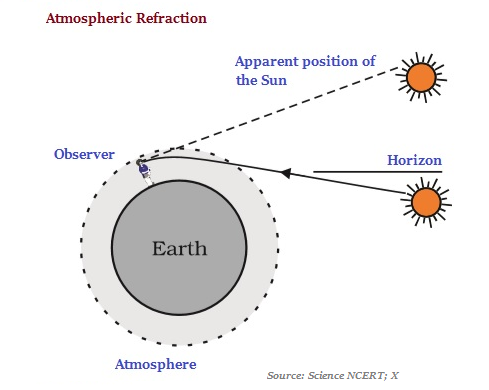
- Physics Notes for UPSC IAS Prelims (Part I)
- Physics - Home
- Physics - Force and Pressure
- Physics - Friction
- Physics - Some Natural Phenomena
- Physics - Motion
- Physics - Force and Laws of Motion
- Physics - Gravitation
- Physics - Mass and Weight
- Physics - Work and Energy
- Physics - Light
- Physics - Reflection and Refraction
- Images Formed by Spherical Mirrors
- Physics - Refraction of Light
- Physics - Spherical Lenses
- The Human Eye & Colorful World
- Refraction of Light Through a Prism
- Physics - Electricity
- Chemical Effects of Electric Current
- Magnetic Effects of Electric Current
- Physics - Electric Motor
- Physics - Source of Energy
- Physics - Sound Part I
- Physics - Sound Part II
- Speed of Sound in Different Media
- Physics - The Solar System
- Physics - Stars and The Solar System
Physics - Refraction of Light Through a Prism
Introduction
Prism is a triangular glass, which has two triangular bases and three rectangular lateral surfaces (as shown in the image given below).

The unique shape of the prism makes the emergent ray bend at an angle to the direction of the incident ray and this angle is known as the angle of deviation.
The angle between two lateral faces of a prism is known as the angle of the prism.
Dispersion of White Light by a Glass Prism
As shown in the image given above, the prism has split the incident white light into a band of colors.
The various colors those are seen through prism are arranged in order; this order is named as ‘VIBGYOR.’
VIBGYOR is constituted after taking first letter of all the following colors −
V − Violet
I − Indigo
B − Blue
G − Green
Y − Yellow
O − Orange
R − Red
The band of the colored components of a light beam is known as spectrum and VIBGYOR is the sequence of colors that you can see in the above image.
The splitting of light into different colors is known as dispersion.
All the colors have different bending angles in respect to the incident ray; the red light bends list (can be seen at the top) whereas the violet bends the most (see the image given above).
Because of having different bending angles, all the colors become distinct.
Newton was the first scientist who used a glass prism to obtain the spectrum of sunlight and he concluded that the sunlight is made up of seven colors.
A rainbow is a natural spectrum that most likely appears in the sky after a rain shower (see the image given below).

Rainbow after the rain is normally result of dispersion of sunlight by the tiny water droplets.
The tiny water droplets present in the atmosphere act like small prisms.
A rainbow always forms in the opposite direction of the Sun.
Atmospheric Refraction
The deviation of light rays from a straight path in the atmosphere (normally because of variation in air density) is known as atmospheric refraction.
Atmospheric refraction nearby the ground produces mirages, which means, the distance objects appear elevated or lowered, to shimmer or ripple, stretched or shortened, etc.
In the night, the stars appear twinkling, it is also because of the atmospheric refraction.
Because of the atmospheric refraction, the Sun remains visible and about 2 minutes after the actual sunset and about 2 minutes before the actual sunrise (see the image given below).

Tyndall Effect
The earth’s atmosphere is largely constituted of a heterogeneous mixture, such as tiny water droplets, suspended particles of dust, smoke, and molecules of air. When a beam of light strikes through such fine particles, the path of the beam gets scattered. The phenomenon of scattering of light by the colloidal particles (of the atmosphere) gives rise to Tyndall effect.
The scattering of light makes the particles visible in the atmosphere.
Very fine particles scatter largely blue light whereas particles of larger size scatter the light, which has longer wavelengths.
The red light has a wavelength (about) 1.8 times larger than the blue light.